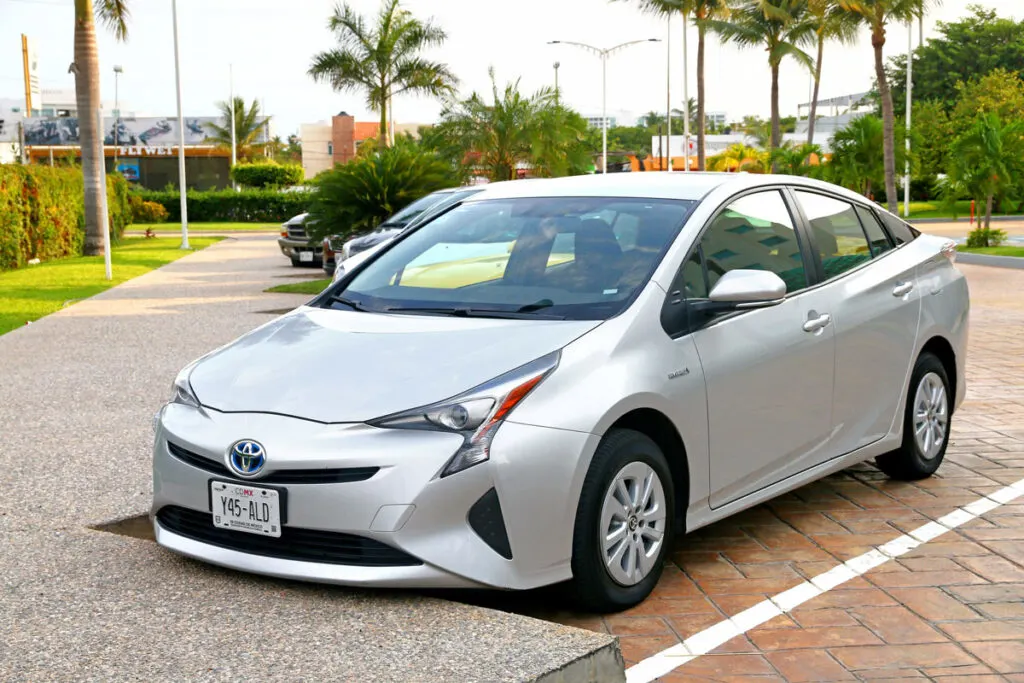Most delivery drivers with Doordash, Instacart, Uber Eats, Grubhub, etc., seem to think their only cost is the gas they have to buy for their car.
Then the IRS tells us it’s 56 cents per mile. At least for 2021 that’s what they say.
Which one is it?
The real cost including the wear and tear on your car for your deliveries with Doordash, Uber Eats, Instacart, Grubhub or any other third party delivery app is usually somewhere in between.
It’s usually a lot less than the IRS number. But a heck of a lot more than just the cost of gas.

The importance of preparing for future costs.
I hear this a lot
“Has anyone noticed what all this driving does to your car?”
There’s this thing called wear and tear on your car. We drive a LOT of miles to do deliveries.
And our cars wear out. WHO KNEW????
It’s incredibly important that you understand the total cost of driving your car for your deliveries with Doordash or Uber Eats. Know what those miles cost you as an independent contractor for Instacart, Grubhub or any others.
There are two reasons that this is so important:
One, you need to know what you’re really making. It’s nice to be able to write off so much for tax purposes, but it’s valuable to know your TRUE profit.
Two, you need to know what to be setting aside. If you know your car costs 30 cents a mile to operate, then put 30 cents aside for every mile you drive each week. If you do that, future costs won’t creep up on you.
Your car is losing value as you drive

How much is your driving costing you in the value of your car? There’s a good chance it’s costing more than gas.
I did this little exercise this awhile ago using a 2018 Toyota Prius with standard equipment in very good condition. I ran a Kelley Blue Book value on the car, with 18,000 miles on it.
Then I ran the value a second time. Everything was exactly the same and even the same condition. The only change was I added 24,000 miles to the mileage (42,000 miles now).
The value was $21,491 the first time. With the additional miles it was $19,516. The only change was the number of miles but the car was now worth $1,975 less.
Every mile on that car was dropping its value by 8.2 cents.

Think about that for a moment.
Leave your house and deliver all day, putting 200 miles on your car. You come home with a car that’s now worth $16.40 less than it was when you pulled out.
That’s not just a number floating out there. That’s a very real cost. It’s a cost you will pay when you sell it or trade it and you get less for it, only because of those miles.
And then there’s the wear and tear and maintenance cost of using your car for delivery.
Every mile you drive is one mile closer to some kind of repair or replacement.
Tires need to be replaced sooner. You need oil changes more often. You need brakes more often. Transmission service is needed more often. Almost all of these things cost you on a per mile basis.
And here’s the thing: you NEED your car if you use it for delivery work, so you MUST perform maintenance to make sure it keeps going for you.
Timing belts. Hoses. ENGINES. It all wears down eventually.
It just happens to wear down even faster when you drive as much as we do for deliveries.
I’ve run the numbers several times in several different scenarios. If you figure in routine maintenance and replacing items on schedule, you’re looking at about 10 to 15 cents per mile just for wear and tear, repair and maintenance.
And then there’s insurance. Now typically insurance is the same if you drive 1 mile or 10,000 (though a lot of insurance companies do take the number of miles driven into account when figuring premiums). A $100 per month insurance policy, or $1200 a year, comes out to 5 cents a mile.
Don’t forget the fixed costs
What’s it costing you to finance your car? If you have a $20,000 car loan at 6% interest, that’s $1200 per year. At 24,000 miles a year, that’s a nickel a mile.
You have to insure your car. Then pay for taxes and registration.
I call these fixed costs because they generally don’t change based on how much you drive. You pay these if the car sits in the driveway all year or if you put 50,000 miles on them.
The IRS figures these things into their standard mileage rate. That can be a little misleading because miles don’t impact the value of the car. That said, there’s a nice simplicity in adding it all up into an average overall cost per mile.
Adding it all up to figure out your actual cost per mile.

What does it really cost to use your car for deliveries? What is the actual cost including wear and tear to deliver for Doordash, Uber Eats, Instacart, Grubhub and any others?
Add up all your actual costs. Then divide by the number of miles.
For longer term costs (depreciation and wear and tear) figure out a per mile cost.
Now add your per mile cost for fixed costs, depreciation, and actual costs.
That’s what it will ultimately cost you to run your car.
Two examples of actual costs.
We’re going to look at two different vehicles. We’ll take a look at a 2018 Toyota Prius and then a 1998 Buick. For purposes of comparison we’ll look at the cost to drive 24,000 miles for each and figure an average cost for fuel at $2.50 per gallon.
The Prius gets 50 miles per gallon. The Buick gets 20. Most would tell you the Prius costs a LOT less to operate.
Let’s compare the two and see what the actual costs are per mile.
The Prius.

Let’s say the Toyota Prius was purchased for $25,000 with a 4% annual interest rate. The car is in excellent condition.
- At 50 MPG, gas is $1200
- The 24000 extra delivery miles dropped $1,975 off the value of the car.
- Interest is $1,000 per year
- Comprehensive insurance that covers delivery work is $150/month or $1800 a year
- Figure repair and maintenance costs are lower being a newer car, at 10 cents a mile. That’s $2400.
- Registration and property taxes were $700 based on an online estimate.
On a newer vehicle, you’re not likely to have the full $2,400 in maintenance costs. Remember that maintenance, repair and replacement tend to be longer term costs. You’ll be replacing tires, an expensive battery and other items eventually, and some of those future costs are related to the miles you drive this year.
Total cost to use the car and drive it that many miles is $9,075.
That averages to 37.8 cents per mile.
The Buick Century.

I chose this because it’s what I drove for awhile.
- At 20 MPG and $2.50 per gallon, gas is $3,000
- The extra 24000 delivery miles dropped $150 off the value of the car
- No interest because the car is paid for
- Comprehensive insurance isn’t needed, insurance $100/month or $1200 for the year
- Repair and maintenance higher than a newer car, 15 cents a mile, or $3600
- Registration and property taxes is $80.
- Those items add up to $8,030, or about 33.5 cents a mile.
Side note: when I sold my Buick in mid 2020, I could actually go back and add up all the costs, as well as factor in the difference between what I received and what I paid for it. The actual cost when all was said and done was 26.1 cents per mile.
Take-aways from this comparison.
The Buick cost two and a half times more for gas costs than the Prius. And yet, the overall cost of the Prius is about 5 cents a mile higher.
But even with the Buick, gas was less than half the overall cost of ownership.
That’s the thing you have to realize: It costs a lot more than gas to operate your car.
The newer Prius cost less in gas but it had far higher costs of depreciation (loss of value), insurance, interest, and registration.
Neither car came close to the IRS allowance of 56 cents per mile (2021).
But here’s the interesting thing: Say you drove a more normal 12,000 miles for the year. On the Prius the changes that means to gas, wear and tear, and depreciation brings overall cost to $6300. That’s 51.5 cents per mile. The IRS isn’t as crazy as you think.
Even on the Buick, the lower miles brings its overall cost to 38.8¢ per mile.
With a better idea of the real wear and tear and ownership of your car for delivery, what do you do with this?

As I said above, it does two things for you:
You know what you’re real expenses are.
You can plan for those expenses.
This is the thing when you drive a lot of miles. You WILL wear your car out. There WILL be some big ticket costs.
It still catches people off guard though when it happens. That’s because it doesn’t seem like a real expense. So many of these costs are piling up on you as you drive but you don’t notice it because the money isn’t coming out of your pocket as you drive.
You can fix that.
I posted in this article about giving yourself a paycheck. I mentioned putting money aside for taxes, for paid time off, and for expenses.
Want to make sure all your expenses are covered INCLUDING the lost value on your car?
Figure out the true long term cost of your car, per mile.
Each week when Doordash, Instacart, Uber Eats, Grubhub and all the other apps put money in your bank, add up how many miles you drove.
Before you touch a penny of that income, multiply that per mile cost times the cost per mile. If you drove 1,000 miles and your cost is 35 cents a mile, that’s $350.
Put that money into an account for your expenses. Pay for your gas, insurance, registration and maintenance out of that account.
You can pay yourself with what’s left over.
What if you can’t afford to do that?
That tells you one thing:
You’re not making enough to cover using your car for delivery.
The thing is, you WILL pay that price. If you don’t put the money aside now, you will have to pay out of pocket.
If you can’t afford to set it aside now, you won’t be able to afford those expenses when they happen. Why would you just wear your car down and put yourself in an impossible situation later?
Does that mean you stop delivering? That depends. If it brings home the reality that you’re not making what you really think, maybe it does.
Or maybe it makes you realize you need to deliver more to make what you need to make.
Possibly it makes you re-think the orders you accept.
Be realistic about what you are making. But be wise with it. Treat your car like a business asset, give yourself the ability to keep that most important asset running, and that will keep you from getting derailed WHEN (not if, but when) something happens with your car.


